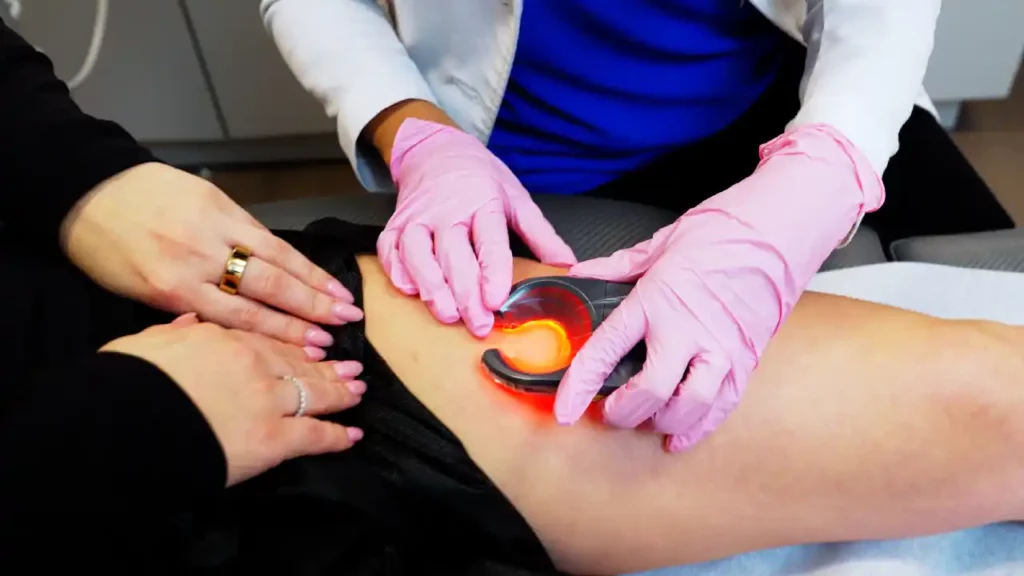What Causes Spider Veins? These Are the Reasons!
You’re getting ready for a night out, slipping into your favorite dress or shorts, when you notice thin, web-like blue and red veins spreading across your legs. These are spider veins, and they might be more than just a cosmetic nuisance. While they may not cause pain or discomfort initially, spider veins can be a sign of underlying venous health issues that could lead to more serious complications if left untreated.
At Vein Treatment, we understand that the appearance of spider veins can be distressing, but we also want you to know that they might indicate a deeper problem. In this article, we explore what causes spider veins and why it’s essential to treat them early. Contact us to schedule a consultation to get started on your journey to healthier legs.
What Are Spider Veins?
Spider veins are small, thin blood vessels that appear just beneath the surface of the skin. They often resemble a spider’s web or tree branches, hence the name. These veins can be red, blue, or purple, and while they can appear anywhere on the body, they’re most commonly found on the legs and face. Spider veins are usually harmless but can sometimes cause discomfort, such as itching or burning sensations. More importantly, their presence can indicate underlying venous issues that require attention.
Spider Veins vs. Varicose Veins
Spider veins and varicose veins are often mentioned together, but they are not the same. Understanding the differences between the two is crucial in determining the appropriate treatment and managing your overall vein health.
Spider Veins
As mentioned earlier, spider veins are small, thin veins that lie close to the skin’s surface. They are usually painless and more of a cosmetic concern, although they can occasionally cause discomfort. Spider veins are typically less than 1 millimeter in diameter and do not bulge out from the skin. While they might seem harmless, they can sometimes be an early sign of chronic venous insufficiency, a more severe condition that could lead to varicose veins if not addressed.
Varicose Veins
Varicose veins, on the other hand, are larger, swollen veins that often appear twisted and bulge out from the skin. They are usually more than 3 millimeters in diameter and can cause significant discomfort, including pain, aching, heaviness, and swelling in the legs. Varicose veins result from weakened or damaged valves within the veins, which cause blood to pool and the veins to enlarge. If left untreated, this can lead to more severe complications.
What Causes Spider Veins?
Several factors can contribute to the development of spider veins. Understanding these causes can help you take preventative measures and seek timely treatment.
Chronic Venous Insufficiency
Chronic venous insufficiency (CVI) is one of the leading causes of spider veins. CVI occurs when the valves in your veins weaken or become damaged, preventing blood from flowing efficiently back to your heart. As a result, blood pools in the veins, causing them to enlarge and become visible under the skin as spider veins. Over time, CVI can lead to more serious conditions like varicose veins or even venous ulcers.
Genetics
Your genetic makeup plays a significant role in whether or not you develop spider veins. If your parents or close relatives have spider veins, you’re more likely to develop them as well. Genetic predisposition affects the strength of your vein walls and valves, making you more susceptible to venous insufficiency and the subsequent development of spider veins.
Hormonal Changes
Hormonal fluctuations, particularly in women, can contribute to the development of spider veins. Pregnancy and menopause can increase hormone levels, which, in turn, can weaken the vein walls and valves. The increase in blood volume during pregnancy, for example, puts additional pressure on the veins, leading to the appearance of spider veins.
Prolonged Standing or Sitting
Occupations or lifestyles that require long periods of standing or sitting can increase your risk of developing spider veins. When you stand or sit for extended periods, your veins have to work harder to pump blood back to your heart, leading to increased pressure in the veins. Over time, this pressure can cause the veins to weaken and form spider veins.
Aging
As you age, your veins naturally lose elasticity, and the valves within them may not function as efficiently as they once did. This loss of elasticity can lead to the pooling of blood in the veins, contributing to the formation of spider veins.
Not Just a Cosmetic Issue: Possible Consequences of Untreated Spider Veins
While spider veins might seem like a minor cosmetic issue, leaving them untreated can lead to more serious health concerns. It’s important to address spider veins early to prevent potential complications.
Progression to Varicose Veins
One of the most common consequences of untreated spider veins is the progression to varicose veins. As the underlying venous insufficiency worsens, spider veins can evolve into larger, bulging varicose veins. Varicose veins are more than just a cosmetic concern; they can cause significant discomfort and lead to more severe conditions.
Venous Ulcers
If venous insufficiency continues to worsen without treatment, it can lead to the development of venous ulcers. These are open sores that usually form around the ankles and are difficult to heal. Venous ulcers are a serious complication that requires medical intervention to prevent infection and further health issues.
Deep Vein Thrombosis
In some cases, untreated venous insufficiency can lead to deep vein thrombosis (DVT), a condition where a blood clot forms in a deep vein, usually in the legs. DVT is a serious medical condition that can cause life-threatening complications if the clot travels to the lungs, leading to a pulmonary embolism. Early treatment of venous issues can help prevent DVT.
Most Spider Vein Treatments Are Covered by Insurance!
Many people assume that spider vein treatments are purely cosmetic and not covered by insurance. However, if your spider veins are linked to venous insufficiency, your treatment is likely to be covered. Most insurance plans cover procedures that address the root cause of the problem, such as chronic venous insufficiency, as these are medically necessary treatments.
At Vein Treatment, we offer a variety of minimally invasive procedures to treat spider veins, including sclerotherapy, endovenous laser ablation, and radiofrequency ablation. These treatments address both the cosmetic appearance of spider veins and the underlying venous insufficiency. Contact us to request insurance verification to see if your treatment is covered, and learn about our varicose vein treatments to find the best option for your needs.
Contact Our Vein Doctors for Spider Vein Treatments
If you’re noticing the signs of spider veins, don’t wait to seek treatment. Early intervention can prevent more serious health issues down the road and improve your quality of life. Our board-certified vein doctors at Vein Treatment are experts in diagnosing and treating spider veins and their underlying causes, such as chronic venous insufficiency.
With state-of-the-art clinics located in New York, New Jersey, Long Island, Maryland, and California, we make it easy for you to access the care you need. Visit your nearest vein clinic or contact us to schedule a consultation today. Our team will work with you to create a personalized treatment plan and help you achieve healthier legs.









